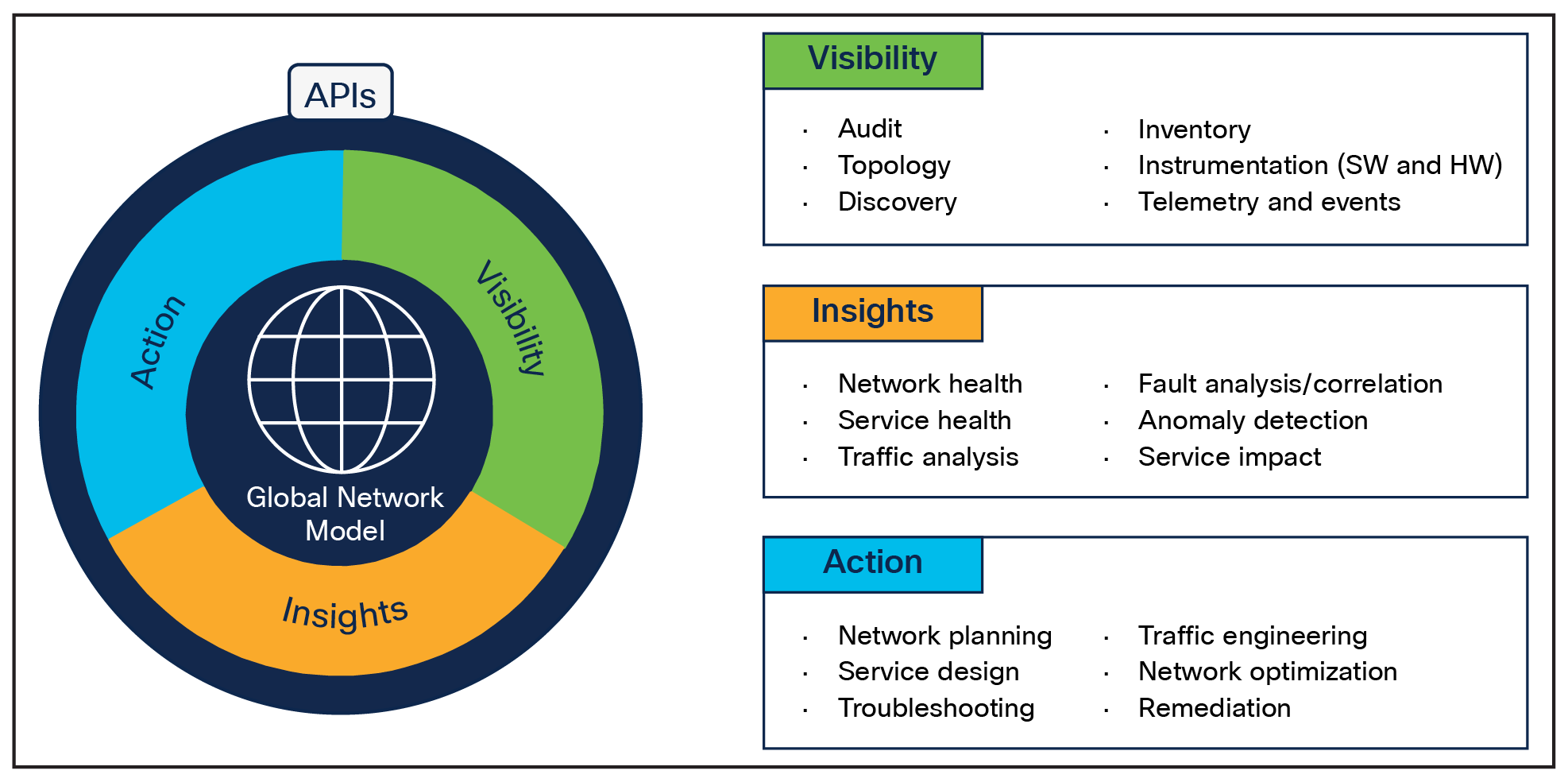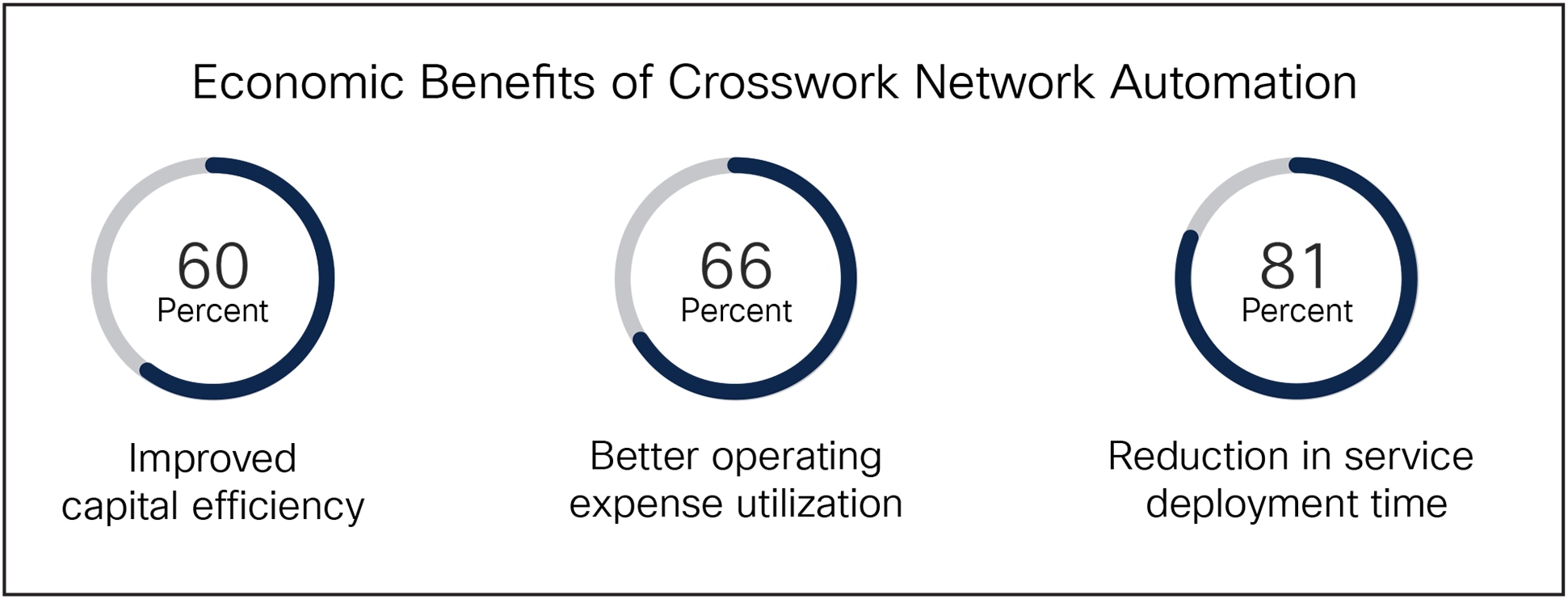Cisco Crosswork Network Automation Solution Overview
Available Languages
Bias-Free Language
The documentation set for this product strives to use bias-free language. For the purposes of this documentation set, bias-free is defined as language that does not imply discrimination based on age, disability, gender, racial identity, ethnic identity, sexual orientation, socioeconomic status, and intersectionality. Exceptions may be present in the documentation due to language that is hardcoded in the user interfaces of the product software, language used based on RFP documentation, or language that is used by a referenced third-party product. Learn more about how Cisco is using Inclusive Language.
The move toward 5G networks, the continued adoption of connected devices, digitization of everyday activities, and the emerging hybrid workplace will all lead to an increase in both the volume of traffic and types of services that need to be delivered securely and at scale over the internet.
Most tools used today by Communications Service Providers (CSPs) and other network operators to deliver and manage services are disparate and take time to navigate, leading to complexity, poor customer experience, and increased Operational Expense (OpEx). As networks become increasingly multifaceted, with many technology layers and vendor domains, and as services become increasingly dynamic, service providers must operate efficiently and cost-effectively using modern tools to stay competitive. End-to-end autonomous, or self-optimizing, networks allow service providers to proactively and competitively respond to changing market demands through automation, virtualization, and SDN innovations combined with AI-enabled analytics and near real-time insights.
To facilitate the networks and operations modernization journey, Cisco designed Crosswork Network Automation, which helps operators simplify network operations and reduce Total Cost of Ownership (TCO).
Accelerating automation transformation with Crosswork Network Automation
Crosswork Network Automation is a comprehensive software platform that simplifies and modernizes operations to meet the explosive demands for dynamic digital services across today’s increasingly complex networks.
The portfolio is built around three functional pillars for advanced automation:
| Visibility |
● Gain deep visibility of the network, with a view of the current state of devices, services, and networks to drive enhanced customer experience.
|
| Insights |
● Apply analytics to gathered data to identify trends and patterns both for planning and problem resolution.
|
| Action |
● Automate operational processes, provide programmatic control of infrastructure, and reduce the latency of end-to-end workflows.
|

Crosswork Network Automation
Crosswork is designed with modern low/no-touch operations in mind. It is a multivendor and multidomain solution, centered on both programmatic infrastructure control and access to operational data, and spans both cloud/ SaaS and on-prem tools. The platform enables automatic, closed-loop operational control and helps execute the complete services, device and network lifecycle management, and operations with speed, precision, and accuracy. This spans visualization, planning, design, implementation, optimization, and ongoing monitoring and assurance of services. AI and machine learning along with human oversight are important parts of the process to ensure both scalable, intelligent automation, and operational integrity.
As an example, a service designer can create a service template for a VPN. Someone can then use that template to request an instance of the service. The high level of programmatic control that Crosswork provides means that the operations staff might not need to be involved at all—a customer could make a request via a customer-facing portal, which then directly routes the request to the automation tooling. Crosswork is intent-based, so it will take the service intent (the customer request to turn up a VPN) and convert that to a set of configuration changes on the underlying infrastructure and implement the changes automatically. Once the changes are successfully made, state and configuration information is updated. If for some reason the update fails, Crosswork can perform a rollback to the prior state and route an error message to the appropriate destination. Once the service is active, assurance and analytics will monitor the service and gather operational data.
The goal of Crosswork Network Automation is to allow both humans and machines to do what each does best to improve the customer experience and drive operational simplicity. In the prior example, the human does the skilled work of designing the service, and the automation tooling replicates it quickly and flawlessly on demand. The sum of these efforts is an expert design efficiently delivered with high quality at machine speed.
Crosswork tools help protect and enhance the customer experience, simplifying the task of troubleshooting and going beyond uniform implementation. Because of the ongoing service monitoring and analytics, Crosswork tools can provide operational insights that shorten the time to root cause analysis and can even be used for auto-remediation. Crosswork also offers predictive Al-enabled capacity planning that empowers network operators to simplify capacity planning and optimize network performance, enhancing operational excellence.
Tenets of Crosswork Network Automation

Tenets of the Crosswork Portfolio
The tenets highlighted in Figure 2 guide the composition of Crosswork, both for tools and ecosystem partnerships. These underlying principles knit the elements of the platform together. The north star for Crosswork Network Automation is fully autonomous, zero-touch operations.
Visualization: Given the complexity of diverse networks and domains, visualization across multiple layers and domain enables customers to manage and operate their IP and optical networks with ease using a single dashboard. Crosswork Network Automation offers a multivendor, multilayer single-pane-of-glass dashboard with the Crosswork Hierarchical Controller (HCO) and leading IP SDN visibility with Crosswork Network Controller (CNC).
The Crosswork Hierarchical Controller (HCO) turns complex multilayer and multivendor infrastructure into a unified, easily controlled network. It extends the architectural simplicity Routed Optical Networking to fulfill and assure any transport service over any combination of IP, optical, and microwave network domains. Rather than making your network control more complex, Routed Optical Networking with Crosswork HCO dramatically simplifies it and enables you to create services that meet strict low-latency and high-availability requirements. Read more.
With the Crosswork Network Controller (CNC), customers can simplify and automate network service provisioning, monitoring, and optimization in a multivendor network environment with a common GUI and APIs. Operators are reducing management complexity, by converging and collapsing their networks, migrating to Software-Defined Networks (SDNs), and automating daily operational tasks to become more efficient and competitive. With CNC, customers can deploy services faster and leverage combined device and service lifecycle management in one. With intent-based service health monitoring, traffic mitigation, and network optimization, CNC simplifies operations, accelerates service delivery, and improves the customer experience. Learn more.
Service provisioning: Spinning up, provisioning, and bringing services and capabilities to market faster is a core differentiator for services providers. Cisco Network Services Orchestrator (NSO) is an industry-leading orchestration platform for hybrid networks that helps deliver services faster and more accurately. It provides comprehensive lifecycle service automation to enable you to design and deliver high-quality services quickly and efficiently. It offers a model-based programmatic interface that allows for control from simple device turn-up and configuration management to sophisticated, end-to-end lifecycle management, improving customer experiences and lowering cost. With 300+ customers and 170+ multivendor devices, NSO is used by the world’s top 10 service providers for network automation and provisioning. Read more.
Network planning: Capacity planning and resource allocation are critical drivers for network managers as it prevents overprovisioning of network resources and in turn saves cost. Crosswork Planning is an AI-enabled network automation tool designed to empower network operators to simplify network planning, optimize performance, and achieve operational excellence with speed, accuracy, and precision. By leveraging predictive AI insights generated using Crosswork network data collection, network engineers can accurately forecast network needs, proactively address future congestion, and ensure optimal resource allocation, resulting in accelerated service delivery and network efficiency. Click here for more information.
Automated assurance: Businesses rely on networks and require strict latency and performance while simultaneously expecting nothing less than flawless network services. For CSPs, this means delivering superior customer experience consistently while assuring high Quality of Service (QoS) in dynamic and complex networks. Crosswork’s automated assurance approach shifts the focus from reactive to proactive so you can resolve problems quickly, even as you rein in capital and operational expense. Intent-based, multilayered, and simplified, automated assurance unifies domains as part of a top-down, service-centric approach. Operators can view performance metrics on a single dashboard and receive alerts in real time if a service is degrading or SLAs are being violated. Accedian, now part of Cisco, actively monitors the end-to-end service performance using embedded assurance sensors, sending performance data and KPIs to Crosswork dynamically for consistent service quality, performance, and end-user experience. For more information on automated assurance, click here.
Workflow management: A fundamental aspect of any network operation and workflow is to operate with reliability, accuracy, and repeatability. The Crosswork Workflow Manager enables customers to build their own automation workflows with capabilities that integrate to existing Operations Support System (OSS) and Basic Service Set (BSS) systems within their environment. New capabilities spanning workflow scheduling, workflow modularity, and catalog tagging have been introduced, enabling customers to rapidly build large collections of automated workflows, efficiently schedule deployments, and organize and manage workloads more effectively. Learn more.
Furthermore, Cisco has also introduced the new Crosswork Router Automation Kit, a collection of prebuilt, commonly used workflows, to help users quickly and easily perform common network maintenance activities across multivendor deployments. Built using Network Service Orchestrator (NSO) and Crosswork Workflow Manage, the Router Automation Kit comprises three key use cases, including fleet upgrade, device onboarding, and golden configuration, and is extensible and usable out of the box.
The business benefits of Crosswork Network Automation can be viewed through two different lenses. From a strategic perspective, the speed achieved through automation allows companies to run their businesses more quickly. The analytics and operational agility that Crosswork provides allows you to spot trends and respond to them quickly. The services you do deploy are built around a much leaner cost structure, which gives you either greater pricing power or improved profitability. Finally, the increased speed and accuracy of service turn-up improves customer experience and customer stickiness, as do the tools Crosswork provides to reduce or eliminate service disruptions.
From an empirical perspective, companies that have deployed Crosswork have realized measurable benefits, including 60% improved capital efficiency, 66% better operating expense utilization, and 81% reduction in time to deploy a service.

Economic Benefits of Crosswork Network Automation
Crosswork’s end-to-end services lifecycle capabilities helps SPs:
● Plan, implement, and deploy services faster than ever before, delivering 81% faster service deployment time. Read more
● Drive 70% time saving for adding a new customer, resolving an incident, handling a change request, disconnecting a service, and managing a Maintenance Operations Process (MOP).
● Enable $70M+ cost saving over 5 years for Tier 1 and 2 service providers and $3 to $16.7M over 5 years for Tier 3, 4, and 5 service providers. [Research]
● Reduce operational time by 90% through automated service management, 35% reduction in mean time to respond, and 50% efficiency gain in root cause detection.
● Achieve millisecond sampling and microsecond accuracy for latency measurements and sub-1% packet loss detection.
● Make smarter business decisions, become more efficient, and reduce operational costs. Read more
This might be a distant goal for you, or it might not be a goal at all—regardless, the Crosswork Network Automation platform is built to meet your needs, regardless of where you are on the journey. Network automation seldom exists in a vacuum. While network operations teams might use Crosswork as a standalone tool, in most instances, Crosswork will exist as part of a larger service automation or business automation toolchain. With that in mind, Crosswork was built with a rich set of software interfaces to allow programmatic control and simplified toolchain integration.
Service providers will find great value in Crosswork Network Automation, so we encourage you to visit the website or contact your Cisco sales representative to schedule a demonstration.